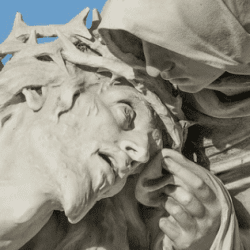Christ’s salvation of humanity is primarily concerned with what is called the doctrine of atonement. While no creedal statement on the atonement exists, the penal substitution theory of atonement has taken on a near creedal status in some evangelical circles. There is a recent and terrifying development afoot among some penal substitution theorists. In some evangelical circles, it is no longer enough to simply believe that Christ made atonement by absorbing the wrath of God or bearing the consequences of the law. Some have gone so far as to claim that, as a penal substitute, Christ became the object of the Father’s ‘perfect hatred.’
If penal substitution is your theory of atonement, here’s a sort of thumbnail sketch of what you’re actually committed to: 1) Christ’s atonement is necessary to his redemptive work; 2) Christ’s death is sufficient to assuage God’s retribution for all humanity; 3) Christ dies as a penal substitute for individual persons; 4) Christ dies in order to absorb the consequences of God’s retribution because of human sin, by being treated by God as if he were those individuals to whom the punishment were due; 5) Christ’s death pays a debt of punishment.
If you think the idea that part of what it means for Christ to make atonement as a penal substitute is that God the Father hated Christ is the way to go, well, you no longer believe in penal substitution. You believe in what we call the Christus Odium (i.e. Christ-hating) theory of atonement, which, as we will see in a moment, means that you are committed to much more than our thumbnail sketch. Before we get into that, let’s think through some statements from those who think they’re lobbying for penal substitution and yet appear to have (perhaps unknowingly) adopted the Christus Odium theory.
We probably are all aware how explicit the Scripture is about God hating certain things. ‘There are six things that the Lord hates, seven that are an abomination to him’ (Prov. 6.16-19). God hates idolatry (Jer. 44.3); he hates hypocrisy (Amos 5.21); he hates divorce (Malachi 2.16). Oh, and lest we forget, God hated his Son too. Right? You can begin to see the initial appeal. If the Father, albeit temporally, hates the Son instead of me, then I am, you might say, off the hook. According to one Christus Odium theorist, ‘the culmination to Jesus’ time on earth was His death on the cross…. In that death the wrath of God was poured out on Christ, and the darkness exploded. In that instant God cursed Jesus, putting Him in a position of absolute, perfect hatred. God hated Him and desired to make Him nothing.’[1] Another pair of scholars have recently described what we have called Christus Odium, ‘God chose to violate His Son in our place. The Son stared into the mocking eyes of God; He heard the laugher of the Father’s derision and felt Him depart in disgust…. In a mysterious instant, the Father who loved the Son from all eternity turned from Him in hatred. The Son became odious to the Father.’[2] Provoking a moment of social media alarm was a recent comment—one that was quickly revised—from a pastor who appears to think that, ‘If you see Jesus losing the infinite love of the Father, out of his infinite love for you, it will melt your hardness.’[3] It seems from such a comment that for those who affirm that God hated his Son, Christianity has a new message, the simple logic of which goes like this: ‘The Son became sin; the Father cannot look upon sin without hatred; The Son willingly took our place of condemnation—and for an instant the Son bore the fury of God.’[4]
If your heart is ‘strangely warmed’ by such statements, here’s (minimally) what you’re committed to: (7) the demands of God’s retributive justice ≈ the experience of divine hatred; (8) Paying the debt to retributive justice, the Son is (temporarily) hated by the Father; (9) The Son of God himself died on the cross; (10) The object of the atonement seems to be the satisfaction of Divine wrath or hatred.
Now, at this point, you might be thinking: ‘My brain just exploded!’ If that’s you, here’s two questions that might help put your head back together. First, how does the penal substitution theory become the Christus Odium theory? Second, when push comes to shove, what’s the big deal? Let’s take each question, one at a time.
Part of the motivation behind the development from minimalist penal substitutionary accounts to this more terrifying version could be the result of pastoral rhetoric. Sometimes the most well-meaning folks can say some pretty un-thinking things. Admit it. We’ve all been there. Right? The problem occurs when that enthusiasm pushes the doctrinal limits. Practically speaking, in one particular case, the steps taken toward the Christus Odium theory appear to be a matter of pastoral enthusiasm that ultimately ends up over-burdening such Biblical-theological categories as kingship and cursedness.[5] In the context of his discussion of the curse, and speaking of the prophetic tradition (specifically Isaiah’s vision), this scholar argues that, ‘The prophets show that all is not lost, for there will be a King to fulfill everything.’[6] Now, as far as Christ’s kingship goes, we have no desire to diminish what it means for him to be the legal representative of his people (i.e. the king). We do, however, want to resist making more of the idea of representationalism than Scripture’s legal paradigms permit, which is one apparent problem.[7] In terms of Christ’s cursedness, which is the second and arguably, the crux of the problem, Paul is quite explicit that ‘Christ became a curse for us’ (Gal. 3.13). This, as Calvin carefully points out, does not mean that Christ was cursed, but that he became a curse. This is quite an important distinction, one that seems lost upon this one exponent of ‘Christus Odium.’ It is not the case, ‘God cursed Jesus, putting Him in a position of absolute, perfect hatred. God hated Him and desired to make Him nothing.’[8] Rather, the curse that was due to others terminated on him. This is what it means for Christ to represent others. Interestingly, Calvin himself goes on to point to John 8:29, which says that the Son, ‘always [does] those things that please Him’, and he argues that, ‘[Christ] could not cease to be the object of the Father’s love, and yet he endured his wrath. For how could [Christ] reconcile the Father to us, if he had incurred his hatred and displeasure’?[9] The obvious answer to Calvin’s rhetorical question is: he couldn’t! What all this means is that at some point the idea of Christ’s paying a debt of punishment for sin metastasized into the idea that being liable to punishment is equivalent to a payment of a debt owed to the violence of divine anger for sin, and even more, divine hatred of the Son.
Hopefully, these questions and answers helped you get your head back together. If so, let’s consider several additional theological reasons as to why the Christus Odium theory is problematic. These reasons have to do more specifically with Christ’s human nature and the Trinitarian nature of God. Seeing as the Christological problem follows from the Trinitarian problem, and seeing as the Trinitarian problem is most obvious, let us begin there.
It’s pretty clear, actually. Bizarre as it may sound, one reason that the Christus Odium theory appears obviously problematic is that God the Father must hate the human nature of Christ, if this is even a logical possibility. We are not sure that it is logically possible. Surely, it would be a logical contradiction for the Father to hate His own divine nature (i.e. the Son).[10] For one thing, the ‘violation’ of the Son, as one author puts it, would yield an unorthodox Trinitarianism. But, how is it then that God could hate the human nature of Christ? To answer this question, we must first point out the fractured portrait of Christ this yields, something that would force one to re-think the Old Testament portrayal of Christ as the perfect image of God (2 Corinthians 4:4; Colossians 1:16) pointing us back to Genesis where humans are portrayed as bearing the image of God, body and soul. Christ, we know, fulfills the image bearing relation we humans have toward God. More importantly, when we consider the Chalcedonian statement and the history of interpretation regarding Christ’s nature, we are confronted with the fact that Christ was first a Divine person (with a corresponding Divine nature), who assumed an impersonalized human nature.[11] It is Christ’s Divine person that supports the human nature. It seems hardly conceivable then that the Father hates the human nature (which is a perfect image and representative of humanity) divorced from the Divine person when in fact the human nature lacks any personal agency apart from the Divine personhood of Christ. The problem for ‘Christus Odium’ is that Christ’s Divine and human natures are divided in a way that is not only unnatural, violating his representational work, but also violates orthodox Christology—something we are loath to do. In the end, it looks like exponents of the Christus Odium theory have pigeonholed themselves into making a not insignificant Christological—and by extension, a Trinitarian—error.
So, what bearing does all this have on evangelicals? Well, we hope to have shown the importance of thinking carefully about the good news of Christ. We do not believe that there is anything good in a gospel where the Father hates the Son. The Father’s loving the Son and being well pleased with the Son’s work on our behalf is a gospel worth believing. That the Father is forever pleased with the Son’s work of salvation wherein the Son out of love to the Father saved us and encourages love in us, is good news. Thankfully, the Christus Odium theory is not the only theory on offer.
[1]https://www.adamsetser.com/blog/2015/7/25/the-big-picture-of-gods-mission-a-concise-overview-of-the-entire-bible-by-dr-abner-chou. [accessed on December 12, 2017]..
[2] Dan B. Allender and Tremper Longman, In the Cry of the Soul: How Our Emotions Reveal Our Deepest Questions About God (Colorado Springs, CO: NavPress, [1999] 2015), pp. 184-85 (emphasis added; hereafter, In the Cry of the Soul).
[3]https://calvinistinternational.com/2017/07/27/tim-keller-the-cross-and-the-love-of-god/ [accessed on December 12, 2017]
[4]Allender and Longman, In The Cry of the Soul, p. 185 (emphasis added).
[5]https://www.adamsetser.com/blog/2015/7/25/the-big-picture-of-gods-mission-a-concise-overview-of-the-entire-bible-by-dr-abner-chou. [accessed on December 12, 2017].
[6]Ibid.
[7]It is not clear whether Chou understands representationalism in terms of owing a debt or owing a debt of punishment.
[8] Chou, Big Picture of God’s Mission.
[9]John Calvin, Commentaries on the Epistle of Paul to the Galatians and Ephesians, trans. by William Pringle (Grand Rapids: Baker, 2005), pp. 91-2 (emphasis added). It is of some additional note that later in John 10.15 and 17, John records Jesus as saying, ‘I lay down my life for the sheep… For this reason the Father loves me, because I lay down my life, that I may take it again’, and in John 17.4, John records Jesus saying, ‘Father, I glorified thee on earth, having accomplished the work which you gave me to do’.
[10]These worries both echo and in several important ways extend beyond what Tom McCall has recently and helpfully labeled ‘broken-Trinity theology, see: Forsaken: The Trinity and the Cross, and Why it Matters (Downers Grove: InterVarsity, 2012), p. 22 (hereafter, Forsaken).
[11]See: Oliver Crisp, Divinity and Humanity (Cambridge: Cambridge University Press, 2007), p. 75ff.
S. Mark Hamilton (Phd Candidate, VU Amsterdam) is co-editor and contributor to two collections of essay in philosophical theology. He is the author of numerous peer-reviewed articles focused on the doctrine of Christ’s person and work and author of a recently published monograph entitled A Treatise on Jonathan Edwards, Continuous Creation and Christology.














